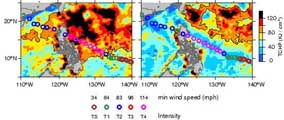TCHP and tropical cyclone intensification
 Upper ocean conditions during hurricane Frances & Ivan
Upper ocean conditions during hurricane Frances & Ivan
We show here examples of intensification of three Atlantic
hurricanes and one Pacific typhoon that passed over areas with very high values of TCHP:
Hurricanes Opal, Mitch and Bret, and typhoon Imbudo.
 | ||
| Opal | Mitch | Bret |
Hurricane Opal in the Gulf of Mexico, August-September 1995 (left):
This TC intensified from hurricane-1 (74-95 mph winds) to hurricane 4 (131-155 mph winds) while traveling over a number of warm features in the Gulf of Mexico. In particular, this TC suddenly intensified from hurricane-2 (96-110 mph winds) to hurricane-4 in a period of 10 hours when its track went over a very well defined ring with a mean radius of 150 km that had been shed by the Loop Current. Altimeter-derived fields indicate that the increase in TCHP associated with this warm ring was approximately 30 kJ/cm2. The most striking information of the ocean conditions during the life span of this hurricane over the Gulf of Mexico was that this warm ring was not detected using the AVHRR-derived sea surface temperature fields.Hurricane Mitch in the Caribbean Sea, October 1998 (center):
This cyclone intensified from hurricane 2 to hurricane 5 (winds above 155 mph) when its track traveled over a region of warm surface waters, experiencing an intensification from hurricane 3 (111-130 mph winds) to 5 with an increase in values of TCHP approximately 80 kJ/cm2 under the track of the TC in 22 hours.Hurricane Bret in the Gulf of Mexico, August 1999 (right):
This hurricane intensified several times in the SW Gulf of Mexico in a period of approximately 36 hours while traveling over two warm features remnants of one warm ring that had been shed by the Loop Current several months earlier. The increase in TCHP under the track of the TC during this period was approximately 80 kJ/cm2.In these cases an association was observed between the increase in TC intensity and a raise in the value of TCHP under the track of each of the TCs. Preliminary evaluation of the upper ocean thermal conditions during the intensification of 32 of the 36 strongest TCs in the tropical Atlantic from 1993 to 2000 indicates that their intensification can be associated with the passage of their tracks over regions, with increased TCHP of at least 20 kJ/cm2.
Typhoon Imbudo in the northwestern Pacific Ocean, July 2003 :
The maps below show de ocean conditions in the northwestern Pacific Ocean, east of the Philipines for July 19 and July 23, 2003.A tropical depression was located at 143E 7.4N on July 16, which became a tropical storm on July 17 at 140.6E 8.5N. On July 18th this tropical storm became a Typhoon-1 (IMBUDO) at 136.2E 10.30N, and suddenly intensified as a typhoon-4 on July 20th with winds over 130 knots, almost reaching the intensity of a super-typhoon (storm data from Unisys Weather).
Near-real time estimates of the upper ocean conditions derived from synthetic temperature profiles obtained from satellite-derived sea height anomalies, sea surface temperatures and climatological fields, revealed that under the storm track, in a region around 131E 12N, and before intensification (July 19th):
1. There are higher sea heigh anomalies, with values of up to 5 cm, due to the warming of the water column below, and associated with a deepening of the depth of the 26.C isotherms of approximately 20m with respect to the surrounding waters.
2. Very high sea surface temperatures, above 29.C.
3. Very high tropical cyclone heat potential, with values above 90 kJ/cm2
The maps from July 23rd show that under the track of this typhoon, a cooling of the sea surface of up to 4.C, due to the mixing of the surface waters, a decrease of tropical cyclone heat potential values of 60 to 100 kJ/cm2, and a rise of the depth of the 26.C isotherm by 25 to 100 m.
 |